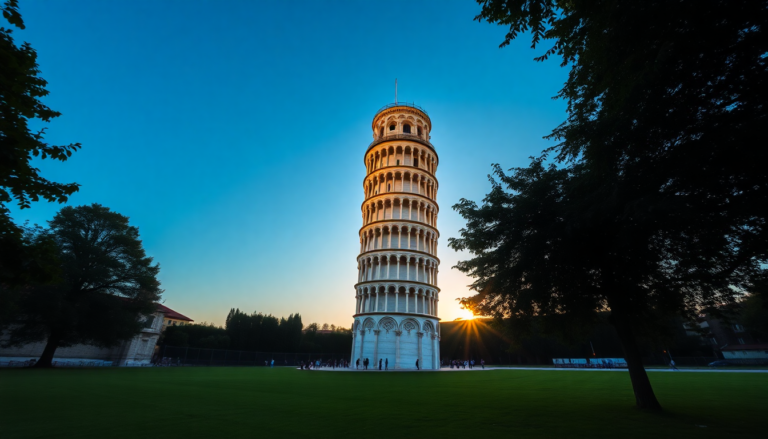Argomenti trattati
As the sun rises over Tuscany, the Leaning Tower of Pisa stands proudly against the blue sky, an architectural marvel that has captivated hearts for centuries. Its famous tilt invites not just admiration but curiosity, leading many to explore the stories hidden within its stones. This iconic structure, a symbol of Italy, offers a unique journey through time, where every step taken towards its base is a step into a world of history and wonder. Have you ever wondered what secrets lie behind those ancient walls?
A Journey Through History
The Leaning Tower of Pisa, standing at approximately 56 meters, is not merely a visual spectacle but a testament to human ingenuity and resilience. Constructed as the freestanding bell tower for the Cathedral of Santa Maria Assunta in the Piazza dei Miracoli, its story begins in 1173. Can you imagine the excitement when the first stones were laid? However, the initial three stories were built before the ground beneath began to shift, prompting a halt in construction that would last nearly a century. This unexpected pause, while seemingly a setback, allowed the unstable foundation to settle, ultimately saving the structure from collapse.
When work resumed in 1275, the architects faced the daunting challenge of correcting the tilt. They ingeniously adjusted the design, creating a slight curve in the upper levels to compensate for the lean. Completed in 1372, the tower is now a robust structure that has undergone various restorations, ensuring its stability for at least another 300 years. Behind the iconic image lies a saga of trials, tribulations, and triumphs, making each visit to the tower a poignant reminder of perseverance. Isn’t it fascinating how history can shape a monument into a symbol of resilience?
The Experience of Climbing the Tower
Ascending the Leaning Tower of Pisa is an unforgettable adventure, marked not just by the breathtaking views one encounters at the summit but also by the physical sensation of its unique tilt as one navigates the 251 steps. This journey is not for everyone; individuals with mobility issues or certain health concerns are advised to consider their options carefully. Children under the age of eight are also restricted from climbing. Are you ready to take on the challenge?
Visitors cannot purchase a ticket for the tower alone; it is typically bundled with access to the Cathedral, or a comprehensive ticket grants entry to the entire Piazza dei Miracoli. This allows for exploration of the Baptistery, the Monumental Cemetery, the Opera del Duomo Museum, and the Museum of Sinopie. The ticket prices vary based on the chosen package, but for those eager to immerse themselves fully in the experience, opting for a complete access pass is highly recommended. Why limit yourself when you can explore the entire marvel of this historical site?
It’s essential to note that the tower has strict regulations: the entrance ticket is valid only for the booked time slot and cannot be altered. In contrast, tickets for other monuments can be used throughout the year during opening hours. Visit schedules also vary by month, with the last entry permitted half an hour before closing time. Visitors have the option to explore independently at their own pace or join a guided tour for a deeper understanding of the tower’s intricacies and secrets. Regardless of the choice, the ascent culminates in one of the most stunning vistas of Pisa and its surroundings. Can you imagine the thrill of standing at the top, looking out over a city steeped in history?
Legends and Mysteries Surrounding the Tower
While the Leaning Tower of Pisa is renowned for its architectural anomaly, it is equally enriched by tales of intrigue and legend. One of the most famous stories associates the tower with Galileo Galilei, who is said to have dropped two spheres of different weights from its height to demonstrate that the speed of fall is independent of mass. This anecdote not only highlights the tower’s scientific significance but also intertwines it with the fabric of Italian history. Isn’t it incredible how such a simple act can change our understanding of physics?
The tower is home to seven bells, each named and designated for specific functions, which once marked the hours of religious and civic life in Pisa. At the entrance, a ram is carved into the stone, a symbol of the city’s astrological and historical identity. This ram signifies the start of the Pisano year, which traditionally began on March 25, under the sign of Aries. Some scholars suggest that the layout of the Tower, along with the Cathedral and Baptistery, mirrors the constellation of Aries itself. How does architecture intertwine with astrology in such a profound way?
Moreover, as twilight descends, whispers of a ghostly knight roaming near the tower surface, said to be visible only during the stillest, foggiest nights. This spectral figure, clad in armor, is believed to watch over the monument, serving as its eternal guardian. Such stories add a layer of enchantment to the experience, inviting visitors to not only appreciate the architecture but also to engage with the myriad tales that breathe life into this historic site. Will you be the next to uncover the mysteries of the Leaning Tower of Pisa?

